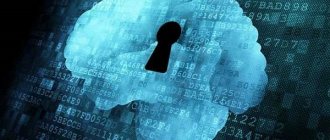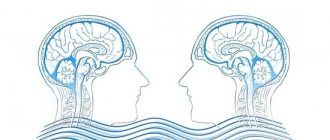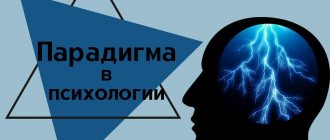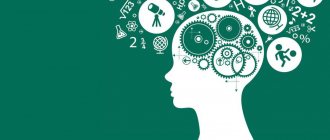What is identification: definitions
What is this? Identification is in psychology the process of an individual’s imitation of another subject, group, fictional character (image); the process of self-identification of an individual with a group, image, or another person. Identification is, in simple words, the search for an answer to the question “Am I the same as who?”
The term was introduced by S. Freud. The psychologist examined the phenomenon within the framework of psychoanalysis. The first thing Freud studied was the child’s identification with one of the parents. At the same time, the researcher came to the conclusion that identification is always based on fear and anxiety. By identifying with a stronger, more authoritative person, the individual reduces the discomfort he experiences.
However, a little later the author identified several types of identification:
- primary (child with mother);
- identification with a loved one (“I want to be like you”);
- identification with an unloved person (a defense mechanism of the psyche, “you will not offend someone like yourself”);
- identification in the perception of community (“stand in my place”, “what would he do”, “what would he think”).
Over time, the concept began to be used in a broader sense. According to him, personal identification is imitation, emotional fusion with someone. However, some psychologists still adhere to the psychoanalytic theory, arguing that it is a defense mechanism developed by evolution that helps in adaptation. Let's take a closer look at modern definitions and find out what identification means in psychology.
Identification
The meaning of the word "identification"
The name is derived from the Latin indentifico, which means “to identify.” Identification is the establishment of correspondence, similarity between two or more objects.
Identification concept
According to definitions from various dictionaries, identification is:
- identification, recognition of objects (encyclopedic dictionary);
- comparison with a standard, identification for litigation (business dictionary);
- subconscious identification of oneself with another person, often a parent (psychiatric dictionary);
- a psychological defense mechanism in which an individual becomes like his offender and identifies himself with him (psychological dictionary);
- a protective mechanism of the psyche, in which a weak person adopts the experience and features of a strong person (psychological dictionary).
In sociology, identification is understood as the process of an individual identifying himself with some group, another person. This is clearly visible in the example of youth subcultures. An individual copies the external attributes, behavior, values, beliefs, and interests of the group.
See also: PSYCHOPHISIOLOGY - directions and tasks
Philosophy and psychology
Studying various processes in nature, as well as the worldview and mental experiences of a person, is a rather difficult matter.
In philosophy, it is often necessary to establish the identity of a known object with an unknown one, compare them and draw certain conclusions. Based on the scientific works of leading scientists in this field, the concept of personal identification was introduced. That is, a person’s attitude towards himself. Closely related to this concept is another one related to psychology and which is one of the types of psychological defense. This is the so-called projective identification. Its principle is that a person identifies himself with another person or group. Therefore, to the question: “Identify - what does this mean?” - you can give a specific answer. In most cases, this is to position yourself as a different person or perceive another person as your continuation. Most often, this is how parents perceive their child. In this case, adults believe that their offspring has fully adopted their own qualities, talents and, as a result, should desire and feel the same way as they do. Hence - music, drawing or sports classes that children hate, unnecessary gifts, misunderstanding of the interests of teenagers, that is, the problem of “fathers and children”. Thus, the meaning of the word “identify” in each individual area of life is original, different from all others. What is common in all cases is that the actions or objects performed are compared and either identified or not.
Types of identification
It can be primary and secondary. In the first case, we are talking about the child's identification with the mother, and later with the parent of the same sex as the child. In the second case, the child’s identification with other people and groups in the process of growing up is implied. It, in turn, is divided into several more subspecies. Let's take a closer look.
Situational
This is clearly noticeable in children during games, in adults - at a meeting, when meeting a new person, etc. In general, in some specific situation or conditions, an individual tries to become the same as a person significant to him.
Group
This is a stable type. It implies an individual’s commitment to the values and goals of a group. Outside of it, the subject lives by the same rules. However, sometimes group identity is situational and superficial. A person does not accept the goals and interests of the group as his own. Once he leaves this group, he will behave differently.
Cultural
This is a process of identification, adaptation to the culture of society. A person needs to find a balance between internal and external. For example, between traditions and innovation, goals and means. The subject has to realize his own potential within a particular society. Accept the norms and values of this world.
Social
This is the process of a person identifying himself as an important, active participant in society. He perceives himself as a social agent, feels that he belongs to some social group, and can pronounce “WE” with complete confidence.
Personal
This is a person’s assimilation to himself, that is, the preservation of his uniqueness. Implies unity of goals, interests, views, beliefs, motives, meanings. No matter what group a person belongs to, he always retains a set of stable characteristics.
Finding a balance between personal and public is one of the most difficult problems in psychology. Sometimes a person becomes so similar to others that he loses himself. He dissolves into other people. He forgets about his essence, loses the unity of his Self, ceases to understand himself, forgets his life story.
See also: Human individuality - what is it
Collectivist
Formed in the process of general activity. The experiences of one person are transmitted to others and become motives for common activity. Collectivist identification manifests itself in complicity and sympathy. Each team member shares the failures and successes of the other. That is, a person feels others as himself.
Sexual
The process of becoming aware of belonging to one of the genders. Interest in the body is especially noticeable in children 2–3 years old.
Gender
The process of realizing which gender (collective image of a man and a woman) a person considers himself to be. It doesn't always match the gender. Gender identity provides the answer to the question “Who do I feel like: a man or a woman?” At the same time, a person understands perfectly well which gender he belongs to. For example, a man can recognize his gender, but at the same time be vulnerable, sensitive, gentle, that is, have a set of traits that are generally characteristic of women. Likewise, a woman, despite her gender, can feel like a “man in a skirt.”
Origin and meaning of the cognate adjective
The verb was not found in the etymological dictionary, but a related adjective was easily found there. And since history miraculously enriches knowledge and makes it voluminous, we cannot leave the reader without this information.
We borrowed the word a long time ago, in the 19th century, from French. In Russian it means “the same.” Naturally, the source language is Latin. In Russian, as we well know, identical is “identical, completely identical.”
True, in living speech a word does not always correspond to its meaning. For example, when we say “identical devices,” we mean that they are identical in function, but not equal in detail. Okay, the reader probably knows all this without us. We have not forgotten that our goal is to “identify.” This discovery is yet to come.
Identification in psychology
This is the likening of an individual to some person, group, or image. Without this, the development and formation of personality is impossible. Very often identification is confused with imitation and identity. Let's look at these connections in more detail.
Identification and simulation
Imitation is conscious imitation. Identification is an unconscious process. Identification helps a person develop and build his life path. However, under unfavorable conditions, unconscious imitation leads to developmental stagnation and dissociation.
Identification and Identity: What's the Difference?
What it is? Identity is the result. Identification is a process. In the first case, a person realizes and recognizes his identity with someone. In the second case, he seeks and finds identity.
Information Systems
In this area, to identify means to assign a certain identifier to a subject or object. It could be a barcode or a password in a particular system. The action of comparing objects with a list of identifiers is also called. Authorization of users on sites occurs almost simultaneously with the process of establishing personal identity. Which leads to confusion of these concepts. It should be understood that on ordinary information sites the user logs in, that is, goes online and gets access to commenting on materials. But for portals where financial payments take place, it is important to identify the person. This means that the system needs to establish whether the action is actually carried out by that particular living person, with last name, first name, passport, who is the owner of the account.
What does identification mean in forensics?
This is a determination of the identity of a person based on general and specific characteristics, for example, fingerprints and handwriting. In addition to identifying individuals, criminologists are engaged in identifying objects:
- seals based on impressions;
- weapons by bullets, cartridges;
- shoes on the tracks;
- tools for burglary or other crime in the wake of burglary or other crime;
- car following wheel tracks;
- other.
The whole is also identified by its individual parts.
See also: CONFORMISM - what is it in simple words
Identification methods
To determine identity, criminologists use static and dynamic methods. The first includes the analysis of the biological and physiological characteristics of the individual:
- palm print, fingerprint;
- shape, features, proportions of the face;
- drawing of the retina, iris;
- height, body proportions, size of arms, legs;
- handwriting, signature.
Most often, dactyloscopy (fingerprint analysis) and identification of a person by appearance are used:
- thickness, length, other features of the limbs;
- back features;
- breast specificity;
- characteristics of shoulders, neck;
- wrinkles;
- shape of the auricle;
- teeth;
- height;
- weight;
- lips;
- nose;
- eyes;
- brows;
- forehead;
- face;
- hair;
- floor;
- age;
- general body type;
- head.
Dynamic methods include the analysis of everything related to behavior:
- speech,
- facial expressions,
- gestures,
- poses,
- gait,
- voice,
- posture.
Science, art and forensics
In chemistry, to identify is to establish an identity between an unfamiliar compound and an already known one. This word has the same meaning in other scientific fields, where experiments are carried out comparing various objects, figures, numerical values, formulas and phenomena. Even in art, identification is sometimes used. It is necessary if, for example, it is necessary to establish the authorship of a work. In this case, scientists carry out a comparative analysis of things written by a writer, poet, composer or artist, and based on the data they identify with them or reject the controversial creation. In forensic science, to identify means to identify a person or his things by comparing existing facts (signs) with unchangeable ones inherent in a particular person. These can include photographs, voice recordings, DNA, fingerprints, blood tests, and others.
Meaning of verb and noun
But our path to the meaning of a verb is not as simple as it might seem at first glance. Why? Because the definition given in the explanatory dictionary is as follows: to identify is “to establish a match, identity.” That is, to complete the picture, we also lack a definition of “identity.” And this is more difficult to do than with other previous research objects, but we will still try to complete the task. So, the meaning of the word identity is:
- Close similarity, equality or equivalence.
- A person’s self-image, attitude towards any nationality or social group.
Naturally, the first meaning is used much more often, and few people, except the scientists mentioned at the beginning, think about the second. But we are interested in the most savvy and educated readers, so we do not hide anything from them.
Offers
To understand the true meaning of the verb "identify" and its meaning, we need to put them in some context. In addition to the usual ones, we will also experiment with a well-known phrase. Let's start with her.
Remember the iconic quote: “I don’t recognize you in makeup...”? Or you could say, “I can’t identify you.” True, in this case, an era of some kind of parallel reality would come, where the language of the machine or the terminator would subjugate the Soviet masterpiece. But if we talk about less terrible consequences, then the humor from the phrase would evaporate.
After we have plunged a little into postmodernism, it’s time to return to modernism, that is, modernity, and make some simpler sentences:
- I can't identify you in the dark, come out into the light, otherwise the camera won't see you.
- It is not possible to identify this document: it was very wet in the rain.
- I can’t identify you: my glasses were left at home.
From the above examples, one can discern one pattern: when it comes to documents and official affairs, the word is in place, and when the conventional register of the language changes and the verb can be replaced by another less bookish one, then this must be done, because the object of the study feels like a stranger in an informal setting. Let the reader think about this at his leisure. After all, this is a fascinating topic.











